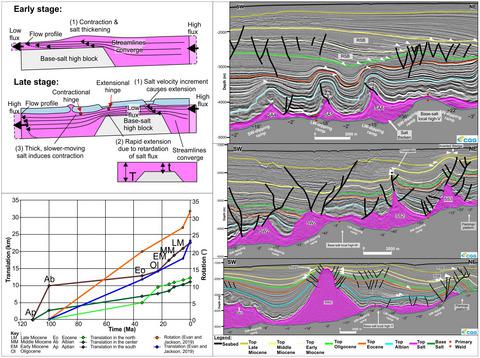当前位置:
X-MOL 学术
›
Basin Res.
›
论文详情
Our official English website, www.x-mol.net, welcomes your feedback! (Note: you will need to create a separate account there.)
What controls salt-detached contraction in the translational domain of the outer Kwanza Basin, offshore Angola?
Basin Research ( IF 3.2 ) Pub Date : 2021-01-11 , DOI: 10.1111/bre.12539 Aurio Erdi 1, 2 , Christopher A‐L. Jackson 1
Basin Research ( IF 3.2 ) Pub Date : 2021-01-11 , DOI: 10.1111/bre.12539 Aurio Erdi 1, 2 , Christopher A‐L. Jackson 1
Affiliation

|
It is now well-established that base-salt relief drives complex deformation patterns in the mid-slope domain of salt-bearing passive margins, in a location classically thought to be dominated by simple horizontal translation. However, due to a lack of detailed studies drawing on high-quality, 3D seismic reflection data, our understanding of how base-salt relief controls four-dimensional patterns of salt-related deformation in natural systems remains poor. We here use 3D seismic reflection data from, and structural restorations of the Outer Kwanza Basin, offshore Angola to examine the controls on the evolution of variably oriented salt anticlines, rollers, and walls, and related normal and reverse faults. We show that the complex geometries and kinematics of predominantly contractional salt structures reflect up to 22 km of seaward flow of salt and its overburden across prominent base-salt relief. More specifically, this contractional deformation occurs where the seaward flow of salt is inhibited due to: (a) it flowing being forced to flow up, landward-dipping ramps; (b) it encountering thicker, slower-moving salt near the base of seaward-dipping ramps; or (c) the formation of primary salt welds at the upper hinge of seaward-dipping ramps. The rate at which salt and its overburden translates seaward varies along strike due to corresponding variations in the magnitude of base-salt relief and, at a larger, more regional scale, primary salt thickness. As a result of these along-strike changes in translation rate, overburden rotation accompanies bulk contraction. Our study improves our understanding of salt-related deformation on passive margins, highlighting the key role of base-salt relief, and showing contraction, extension and rotation are fundamental processes controlling the structural style of the mid-slope translational domains of salt basins.
中文翻译:

是什么控制着安哥拉近海宽扎盆地外平移区的盐分收缩?
现已公认的是,在传统上认为以简单的水平平移为主导的位置中,基盐释放在含盐的被动边缘的中坡域中驱动复杂的变形模式。但是,由于缺乏有关高质量3D地震反射数据的详细研究,我们对碱盐释放如何控制自然系统中与盐有关的变形的四维模式的理解仍然很差。我们在这里使用来自安哥拉近海外宽扎盆地的3D地震反射数据和结构恢复,来检查对变化取向的盐背斜,辊和壁以及相关的正断层和反向断层的演化的控制。我们表明,主要是收缩性盐结构的复杂几何形状和运动学反映了高达22 km的盐向海流动及其在显着的基础盐释放过程中的覆盖层。更具体地,这种收缩变形发生在由于以下原因而阻止盐向海流动的情况:(a)它的流动被迫向上流动,向陆倾斜的坡道;(b)它在向海倾斜的坡道底部附近遇到较浓,移动较慢的盐;(c)在向海倾斜坡道的上铰链处形成初级盐焊缝。盐及其上覆岩向海平移的速率会随罢工而变化,这是由于基础盐释放量的变化以及在更大,更区域性的范围内初级盐厚度的变化所致。由于翻译率的不断变化,覆土旋转伴随着整体收缩。我们的研究提高了我们对被动边缘上与盐有关的变形的理解,强调了基盐释放的关键作用,并显示出收缩,伸展和旋转是控制盐盆地中坡平移域结构样式的基本过程。
更新日期:2021-01-11
中文翻译:

是什么控制着安哥拉近海宽扎盆地外平移区的盐分收缩?
现已公认的是,在传统上认为以简单的水平平移为主导的位置中,基盐释放在含盐的被动边缘的中坡域中驱动复杂的变形模式。但是,由于缺乏有关高质量3D地震反射数据的详细研究,我们对碱盐释放如何控制自然系统中与盐有关的变形的四维模式的理解仍然很差。我们在这里使用来自安哥拉近海外宽扎盆地的3D地震反射数据和结构恢复,来检查对变化取向的盐背斜,辊和壁以及相关的正断层和反向断层的演化的控制。我们表明,主要是收缩性盐结构的复杂几何形状和运动学反映了高达22 km的盐向海流动及其在显着的基础盐释放过程中的覆盖层。更具体地,这种收缩变形发生在由于以下原因而阻止盐向海流动的情况:(a)它的流动被迫向上流动,向陆倾斜的坡道;(b)它在向海倾斜的坡道底部附近遇到较浓,移动较慢的盐;(c)在向海倾斜坡道的上铰链处形成初级盐焊缝。盐及其上覆岩向海平移的速率会随罢工而变化,这是由于基础盐释放量的变化以及在更大,更区域性的范围内初级盐厚度的变化所致。由于翻译率的不断变化,覆土旋转伴随着整体收缩。我们的研究提高了我们对被动边缘上与盐有关的变形的理解,强调了基盐释放的关键作用,并显示出收缩,伸展和旋转是控制盐盆地中坡平移域结构样式的基本过程。



























 京公网安备 11010802027423号
京公网安备 11010802027423号